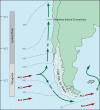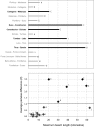Contemporary habitat discontinuity and historic glacial ice drive genetic divergence in Chilean kelp
- PMID: 20594354
- PMCID: PMC3020628
- DOI: 10.1186/1471-2148-10-203
Contemporary habitat discontinuity and historic glacial ice drive genetic divergence in Chilean kelp
Abstract
Background: South America's western coastline, extending in a near-straight line across some 35 latitudinal degrees, presents an elegant setting for assessing both contemporary and historic influences on cladogenesis in the marine environment. Southern bull-kelp (Durvillaea antarctica) has a broad distribution along much of the Chilean coast. This species represents an ideal model taxon for studies of coastal marine connectivity and of palaeoclimatic effects, as it grows only on exposed rocky coasts and is absent from beaches and ice-affected shores. We expected that, along the central Chilean coast, D. antarctica would show considerable phylogeographic structure as a consequence of the isolating effects of distance and habitat discontinuities. In contrast, we hypothesised that further south--throughout the region affected by the Patagonian Ice Sheet at the Last Glacial Maximum (LGM)--D. antarctica would show relatively little genetic structure, reflecting postglacial recolonisation.
Results: Mitochondrial (COI) and chloroplast (rbcL) DNA analyses of D. antarctica from 24 Chilean localities (164 individuals) revealed two deeply divergent (4.5 - 6.1% for COI, 1.4% for rbcL) clades from the centre and south of the country, with contrasting levels and patterns of genetic structure. Among populations from central Chile (32 degrees-44 degrees S), substantial phylogeographic structure was evident across small spatial scales, and a significant isolation-by-distance effect was observed. Genetic disjunctions in this region appear to correspond to the presence of long beaches. In contrast to the genetic structure found among central Chilean populations, samples from the southern Chilean Patagonian region (49 degrees-56 degrees S) were genetically homogeneous and identical to a haplotype recently found throughout the subantarctic region.
Conclusions: Southern (Patagonian) Chile has been recolonised by D. antarctica relatively recently, probably since the LGM. The inferred trans-oceanic ancestry of these Patagonian populations supports the notion that D. antarctica is capable of long-distance dispersal via rafting. In contrast, further north in central Chile, the correspondence of genetic disjunctions in D. antarctica with long beaches indicates that habitat discontinuity drives genetic isolation among established kelp populations. We conclude that rafting facilitates colonisation of unoccupied shores, but has limited potential to enhance gene-flow among established populations. Broadly, this study demonstrates that some taxa may be considered to have either high or low dispersal potential across different temporal and geographic scales.
Figures





References
-
- Caley MJ, Carr MH, Hixon MA, Hughes TP, Jones GP, Menge BA. Recruitment and the local dynamics of open marine populations. Annu Rev Ecol Syst. 1996;27:477–500. doi: 10.1146/annurev.ecolsys.27.1.477. - DOI
-
- Hellberg ME, Burton RS, Neigel JE, Palumbi SR. Genetic assessment of connectivity among marine populations. Bull Mar Sci. 2002;70(1):273–290.
Publication types
MeSH terms
Substances
Associated data
- Actions
- Actions
- Actions
- Actions
- Actions
- Actions
- Actions
- Actions
- Actions
- Actions
- Actions
- Actions
- Actions
- Actions
- Actions
- Actions
- Actions
- Actions
- Actions
- Actions
- Actions
- Actions
- Actions
- Actions
- Actions
- Actions
- Actions
- Actions
- Actions
- Actions
- Actions
- Actions
- Actions
- Actions
- Actions
- Actions
- Actions
- Actions
- Actions
- Actions
- Actions
- Actions
- Actions
- Actions
- Actions
- Actions
- Actions
- Actions
- Actions
- Actions
- Actions
- Actions
- Actions
- Actions
- Actions
- Actions
- Actions
- Actions
- Actions
- Actions
- Actions
- Actions
- Actions
- Actions
- Actions
- Actions
- Actions
- Actions
- Actions
- Actions
- Actions
- Actions
- Actions
- Actions
- Actions
- Actions
- Actions
- Actions
- Actions
- Actions
- Actions
- Actions
- Actions
- Actions
- Actions
- Actions
- Actions
- Actions
- Actions
- Actions
- Actions
- Actions
- Actions
- Actions
- Actions
- Actions
- Actions
- Actions
- Actions
- Actions
- Actions
- Actions
- Actions
- Actions
- Actions
- Actions
- Actions
- Actions
- Actions
- Actions
- Actions
- Actions
- Actions
- Actions
- Actions
- Actions
- Actions
- Actions
- Actions
- Actions
- Actions
- Actions
- Actions
- Actions
- Actions
- Actions
- Actions
- Actions
- Actions
- Actions
- Actions
- Actions
- Actions
- Actions
- Actions
- Actions
- Actions
- Actions
- Actions
- Actions
- Actions
- Actions
- Actions
- Actions
- Actions
- Actions
- Actions
- Actions
- Actions
- Actions
- Actions
- Actions
- Actions
- Actions
- Actions
- Actions
- Actions
- Actions
- Actions
- Actions
- Actions
- Actions
- Actions
- Actions
- Actions
- Actions
- Actions
- Actions
- Actions
- Actions
- Actions
- Actions
- Actions
- Actions
- Actions
- Actions
- Actions
- Actions
- Actions
- Actions
- Actions
- Actions
- Actions
- Actions
- Actions
- Actions
- Actions
- Actions
- Actions
- Actions
- Actions
- Actions
- Actions
- Actions
- Actions
- Actions
- Actions
- Actions
- Actions
- Actions
- Actions
- Actions
- Actions
- Actions
- Actions
- Actions
- Actions
- Actions
- Actions
- Actions
- Actions
- Actions
- Actions
- Actions
- Actions
- Actions
- Actions
- Actions
- Actions
- Actions
- Actions
- Actions
- Actions
- Actions
- Actions
- Actions
- Actions
- Actions
- Actions
- Actions
- Actions
- Actions
- Actions
- Actions
- Actions
- Actions
- Actions
- Actions
- Actions
- Actions
- Actions
- Actions
- Actions
- Actions
LinkOut - more resources
Full Text Sources

